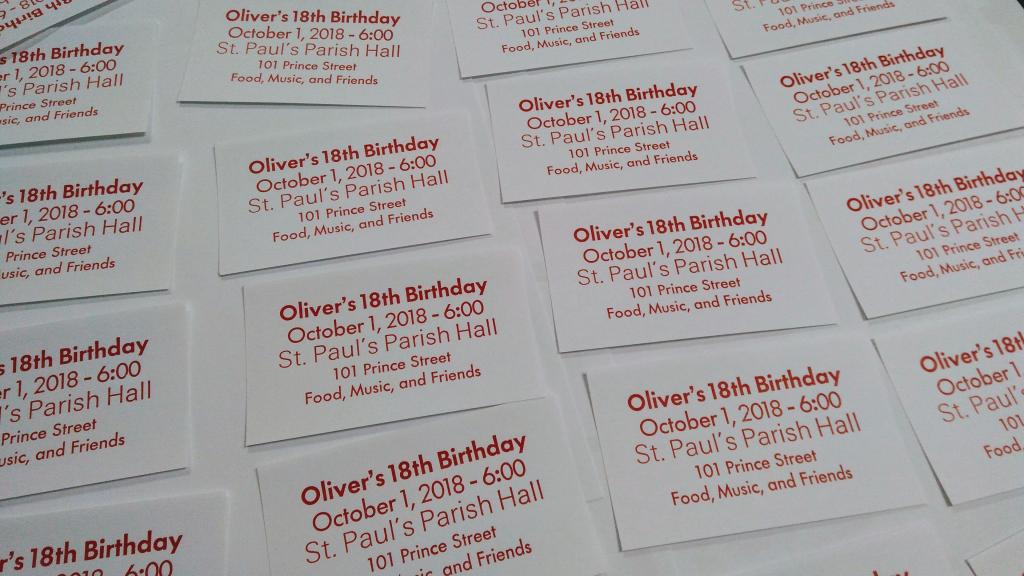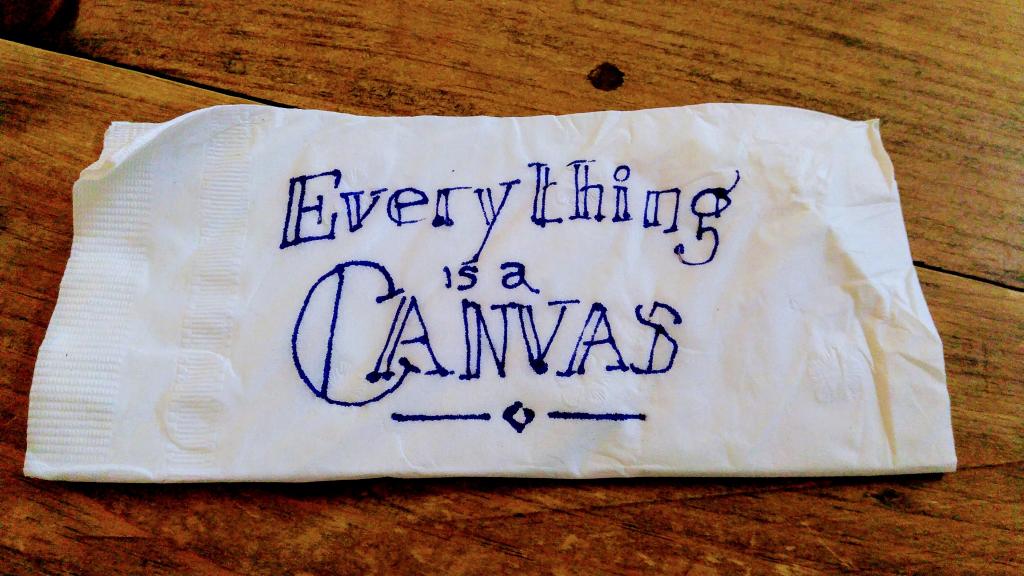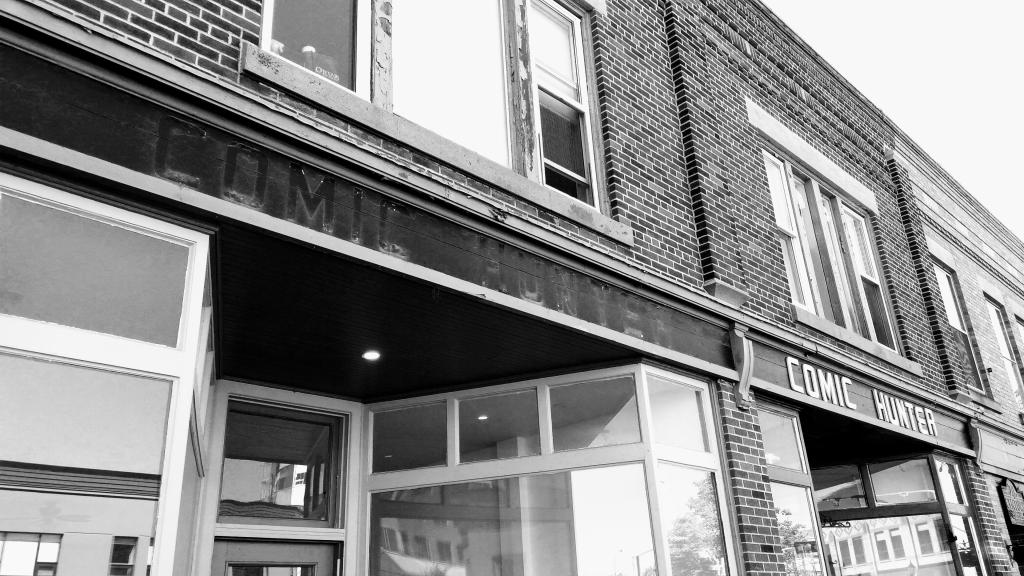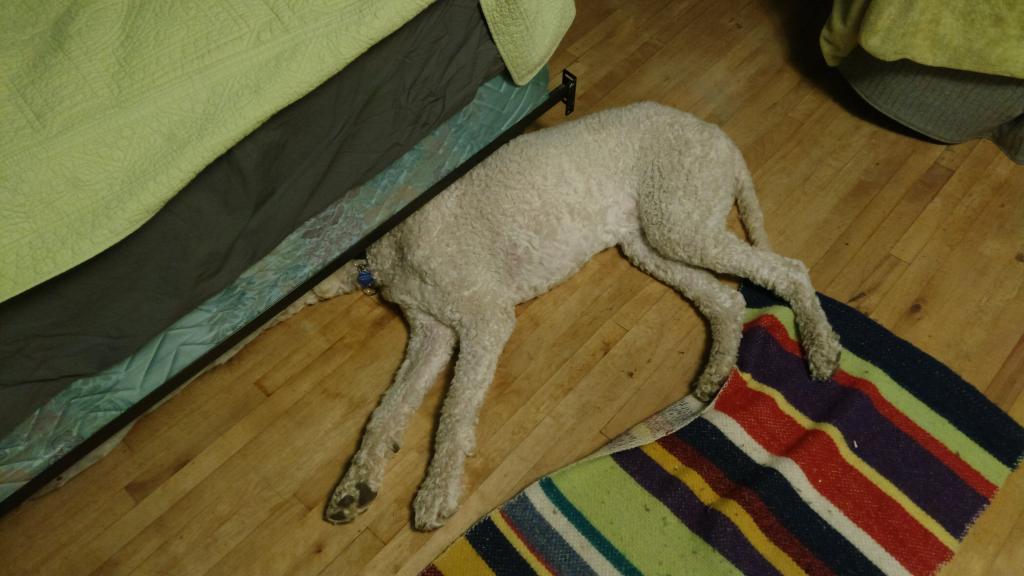For the past year (or more), Oliver’s been focused intensely on October 1, 2018, the day he turns 18 years old and becomes an adult.
A big part of this has involved organizing a birthday party that includes people that have been a part of his life to date. What we’ve discovered this week is that’s a lot of people: schoolmates, daycare workers, teachers, farmers’ market vendors, politicians, childhood friends, and the doula that was there at the very moment of his birth.
We’ve rented the St. Paul’s Parish Hall for the evening, organized a meal of vegetarian chili, and booked a cross-section of musical acts that have touched on Oliver’s life.
It promises to be a barn-burner of an event. If your life has overlapped with Oliver’s and somehow the reach of his invitation blanket had missed you, please come.

I was toying with the idea of going to Nuremberg in October for IndieWebCamp, as all the cool kids will be there.
I’ll be in Boston on October 19, so I looked for Boston to Nuremberg flights that evening. To my surprise, I found a one-way fare of $315 Canadian on Kayak.
Unfortunately it’s a marathon Boston to Reykjavik to Copenhagen to Milan to Nuremberg routing that takes 35 hours and would put me in Nuremberg with IndieWebCamp all but over.

Wednesday morning and Catherine was off early to the hospital for a scan so Oliver and I came to Receiver Coffee for breakfast out.

While I was emptying the leak buckets in the attic this evening, I came across this photobooth picture of Catherine and me. It must have been taken in 1992 or 1993—25 years ago!—as neither of us is wearing eyeglasses.
How young we were; literally half a lifetime ago.

David Noel recommends a visit to Mucem when in Marseille.
The museum has a better-than-usual focus on accessibility:
Recognising the need to surround itself with experts in disability so as to consider and create a global accessibility policy, from the outset of the project, the Mucem formed a committee bringing together Marseille-based associations representing disability. Together, they considered the physical, sensory and cognitive accessibility of the museum.
The museum includes a “tactile and sensory” route through its galleries:
The objects selected for this tour convey the fundamental points of the exhibition’s main themes. In addition, its tactile, sensory dimension allows all visitors to comprehend the objects, through both their intellects and their senses.
I wish all institutions placed such emphasis on meeting all of their patrons where they stand.
(I met David years ago on a visit to SoundCloud; he was one of the most welcoming people I’ve ever met; I take his recommendations seriously).
Madeleine Morley assembled a delicious list of 46 bookshops around the world.
I’ve been lucky to visit four of them so far.
I could do worse in life than to send this list to my travel agent and ask them to book flights connecting the rest.
(Aeroplan round-the-world itineraries start at 200,000 miles; I’m about 1/5 of the way there).
The Athens Zine Bibliotheque is “a zine-library, collecting zines from around the world, focusing mainly on the field of architecture, design, photography and art.”
Comic Hunter has consolidated down to a single storefront, leaving a subtle vestige of itself in the process.

At the tail end of our trip to Europe at the end of August, on the flight home, Oliver and I talked about the value of creating a list of what went well (so we can remember to do it again) and what didn’t (so we can avoid or work around it). We weren’t talking about macro issues, like “go back to Amsterdam again!” (which is a good idea in its own right), but rather things like “remember that you need to have €20 of balance on your Dutch transit chip card to be able to take the train.”
The idea mirrors the practice of we programmers to add comments to our code as a guide to others (and to our future selves): here be dragons, watch out for this pothole, this might seem like it won’t work, but it does. And so on.
So here’s the list from our trip.
Halifax Airport
- Getting There
- Every time I book air travel to Europe I thrash about trying to avoid driving to Halifax to save money (which is almost always possible because of cheaper flights from there as opposed to Charlottetown). And every time I end up giving up and booking a flight from Halifax. It turns out that the drive over and the drive back isn’t such a pain in the ass as I think it will be, and, especially on the return trip, serves as a kind of pleasant segue back into regular life. So, next time don’t sweat it.
- The Quality Inn Halifax Airport is a dreadful looking tired old hotel with three great benefits: 14 days of free long-term parking with any reservation, very comfortable beds, and a quick and helpful airport shuttle; if you need parking, this is the place to stay. And don’t be put off by how the hotel looks from the outside.
- At the Airport
- Having loads of time at the airport is way, way better than not having loads of time. Arrive three hours before the flight and things will be much calmer.
- After checking baggage and before security, if you have time to kill, head over the pedway to the lobby of the Alt Hotel: it’s much more pleasant there than anywhere else at the airport, has acceptable coffee, comfortable chairs, outlets for power devices, and clean washrooms.
- Delay going airside until as late as possible, as there’s almost nowhere calm and peaceful once you pass security, especially in the international departures area.
- Ask the triage agent at the entrance to security to use the special services lane: things will go much faster, and the agents there know to expect the unexpected.
Condor Transatlantic Flight
- On the Airplane
- The regular economy seating is very tight; Premium Economy might be worth it for this reason alone.
- Purchasing the €9 “premium entertainment voucher,” either on-board or in advance, is a good idea; without it, the seat back entertainment system’s free offerings are just a couple of older movies and a lot of German documentaries about the cities that Condor serves.
- The “premium food” is really just “special meals” by another name (vegetarian, etc.). No need to order it.
- There’s USB power in the seat back, next to the video screen.
- The morning snack offered just before landing isn’t substantial and you might want to take a little something extra to take the edge off.
Frankfurt Airport
- Connections
- Depending on the gate you arrive at, and the gate you’re departing from, you may unexpectedly have to clear security while in transit. There are resources online that can smooth the way if you know your starting point and destination; there was some suggestion that an A-B transfer through the “passenger tunnel” was a good way to bypass security, and this proved true for us on the return flight.
- The security screening at Frankfurt uses the “stand in this awkward position for a few seconds” scanners, which can be challenging; request a physical search instead.
- At the Airport
- The airport will seem more chaotic than you think it will after a sleepless night flying from Canada; pace yourself, take breaks, find a quiet spot.
- There are many areas in the airport that have so-called Silent Chairs, which screen out noise, and allow you to plug-in a headphone jack to your device to beam sound at yourself (and nobody else). They proved an excellent distraction and way to relax.
- The Movie World, which seemed so promising, turned out to be filled with people flaked out and trying to sleep.
- There are many, many places to eat and get good coffee; most of them are clustered in the hub of the hub-and-spoke terminals.
- Almost every Lufthansa gate has a coffee machine that accepts credit cards and Euro coins if you’re in a pinch for coffee.
- There’s free, fast wifi all through the airport.
Copenhagen Airport to Malmö
- Transportation
- There’s a bank of ticket machines to your left as you approach the entry to the trains that usually has much shorter lines.
- The trains to Malmö leave from Track 1, the entrance to which isn’t immediately obvious: it’s the first entrance you come to, before you get to the forest of ticket machines.
- The trains to Malmö aren’t necessarily labeled “Malmö,” as they may be continuing on to other destinations; look for Malmö in the tinier list of cities below the main destination on the video displays.
- Getting off the train at the Triangeln station can make a lot of sense if your destination is in a neighbourhood farther from the downtown core.
- There are two exits from Triangeln: the north (norra) exit, comes up in front of St. Johannes Church and the Triangeln shopping mall; the south (södra) exit comes up close to the hospital district and nearer Carl Gustafs väg; it’s also the closer exit to Möllevångstorget.
Malmö
- Telephone
- You can get a SIM card most easily at the Pressbyrån newsstands located at most train and bus stations; they can sell you the SIM cards, and also top-up cards. Good results in 2018 with a Lycamobile SIM.
- Transportation
- The easiest way, by far, to pay for public transit is with the Skånetrafiken mobile app: it’s well designed, can be connected to your overseas credit card, and has a built-in timetable. You can buy tickets right inside the app; you then “pay” by holding your phone on the scanners just inside the front door on buses (hold the phone horizontally up against the glass). There are older scanners for the stored value “Jojo” cards closer to the front of the bus; don’t use those for the app.
- Transit works on the timed ticket system: your ticket entitles you to unlimited travel, in any mode, anywhere in the city, for an hour. You can even change directions and go back to where you came from.
- Every bus we rode on had free on-board wifi.
- Commerce
- The practice at cafés, even if you order at the counter, is to order, sit, eat, then pay; generally it seems you can take a seat on your own, and expect a server to come around to take your order.
- Some restaurants don’t take cash.
- Old problems with overseas credit cards not being accepted appear to have been solved: my Mastercard was accepted everywhere, and usually with a “tap” not requiring a PIN.
- Drewex is a good place for art supplies, stationery, etc. Mattonbutiken is also good (and is beside a hardware store).
Danish Trains
- First Class
- First class is worth the difference in cost (as long as it’s not exorbitant) for access to the lounge in Copenhagen (spartan, but quiet), and for the quiet seating and access to snacks. Seating was 2-1, and book two window seats facing each other in the “1” side is best.
- Power and Wifi
- There’s good free wifi in the station, and bad free wifi on the trains. First class seats have power points, but they are above you, and don’t easily hold a Mac power brick, so having an extension cord would help next time.
- Connections
- There’s no problem changing trains in Fredericia, even though the connection time looks tight: they’re waiting for you across the platform.
German Trains
- First Class
- First class is hit or miss: on a modern carriage it can be quiet pleasant, but on an older train you can be sandwiched into a compartment for six people, off a tight hallway, while those in second class are actually enjoying more room.
- The first class DB Lounge isn’t Shangri-La, and it can be noisy, but there are good washrooms, access to coffee and drinks and a few snacks.
- Power and Wifi
- Sometimes there’s wifi on the train, sometimes there’s not.
- Power points are down low, under or beside the seat.
- On the Train
- The snackbar car is fun to hang out it.
Berlin
- Transportation
- The S-Bahn leaves from the top floor of Berlin Hauptbahnhof, platforms 15 and 16. This isn’t immediately obvious.
- Taking an intercity train from Berlin Ostbahnhof can be easier than from Hauptbahnhof: the Ostbahnhof station is smaller, less crowded, and is walking distance from Kreuzberg. If you’re going west, you might find that your train starts at Ostbahnhof anyway, meaning you’ll board earlier and be settled by the time the crowds descend at Hauptbahnhof.
- The best bet for transit is to buy an A-B day pass for unlimited access to U-Bahn, S-Bahn, trams and buses in the A and B zones (which is likely anywhere you’ll be going).
- Transit works on the honour system: there are no gates, you simply are required to demonstrate that you have a ticket if an inspector asks to see it.
- There are ticket machines on most U-Bahn and S-Bahn platforms that accept credit cards and dispense single-use and day tickets.
- Commerce
- Credit card acceptance is less than elsewhere in Europe still, and cash will often be the only way to pay.
- Modulor is the best stop for stationery, art supplies, and really almost anything.
Amersfoort
- Transportation
- The best bet for transit, both in Amersfoort and across the entire country, is to buy an “anonymous OV-chipkaart” from a machine in a bus or train station. This is a stored-value card that can be used on buses, trams and trains. The card itself costs money–€7,50 in summer 2018–and then you top it up with machines using a credit card.
- The way you insert a credit card into the OV-chipkaart machines isn’t immediately obvious: there’s an unusual “slide in horizontally and then push forward” mechanism. You’ll get used to it.
- To use an OV-chipkaart on a train requires a minimum €20 balance on the card; to use it on a bus or tram requires a minimum €4 balance; if you don’t have the minimum balance, scanners at the gates won’t let you in, and you will be very confused.
- Transit works on the tap in, tap out system: you tap your card on a reader when you get on the bus (or when you enter the train station), and then tap your card again when you exit the bus or train station; your fare is then calculated based on your departure and arrival points, and value deducted from your card. If you are left with a negative balance, you can “top up” at a special machine made for this purpose beside the exit gates in the station.
- It is possible to walk through Amersfoort station from one side to the other, but you need to “check in” at the machine on one side to “purchase” a free right to tap in and tap out in the same station. It’s weird, but it works.
- Commerce
- Pippos is a good place to get paper, pens, craft supplies, and similar items.
- Frozen waffles appear to be unheard of in grocery stores.
- Stroopwafels are not waffles as you know them: they are a sugary dessert item, not one you’d want to eat for breakfast.
- Bagels with smoked salmon can be found at Bagels & Beans.
- The little convenience shop inside the train station entry gate is a good place for a quick breakfast or refreshment; your credit card will work in the self-checkout machine.
Amsterdam
- Transportation
- Don’t assume that going to Central Station is the best way to come into the city; there are many interconnections between trains and the metro, and you can avoid crowds by looking for more direct routes.
- There are bicycle rental shops almost everywhere; some of the larger ones offer cargo bikes and tandem bikes.
- Commerce
- The practice at cafés, even if you order at the counter, is to order, sit, eat, then pay; generally it seems you can take a seat on your own, and expect a server to come around to take your order.
- Almost everywhere accepts credit cards, but a few cafés we visited were cash-only.
- Van der Linde is a good place for art supplies, pens and paper; the Gebroeders Winter a few doors up as a post office outlet, and there’s a mailbox just on the other side of the bridge on Prinsengracht.
Amsterdam Airport Schiphol
- Transportation
- It’s quick and cheap to get to the airport by public transit.
- Negotiating the way from the train station to the departure area can be tricky: the way is not well-signed, and you are starting from an area that looks more like a shopping mall. Stop, take a deep breath, and take it slow.
- At the Airport
- If you have a DPNA number (for “passenger with intellectual or behavioural impairments”), which you can get assigned by your airline’s medical office, you can visit an Assistance Desk in the airport (there are several, they are well-signed and well-staffed) and they will assign someone to accompany you through check-in and security. This can be a huge help for negotiating the way through the airport.
- There isn’t much in the way of coffee or food once you pass through security to Schiphol’s “B” wing.
- There’s free, fast wifi all through the airport.
- There are coin- or credit-operated massage chairs in the “B” wing, just as you enter. They are only €2 for a good long massage, and Oliver enjoyed this.
Halifax Airport
- Arrival
- Making a list, on the airplane, of everything we purchased, along with its value in Canadian dollars, was a good idea, and was appreciated by the Border Services agent. Remember to get the current conversion rates before boarding the airplane to avoid a last minute panic.
- There is a “Crew and Special Services” lane to the far left in the customs arrival hall; take that lane.
- Getting Home
- Staying overnight near the airport on returning from Europe is a no-brainer: you will be too tired, after a long day of getting to the airport in Europe and then spending 7 hours sitting on an airplane, to even think about driving back to PEI.
- It’s a good idea to duck into Halifax for coffee and a good meal before driving home: getting into Halifax isn’t nearly as troublesome as you think it will be.
- Stopping at the Cranewood Bakery in Sackville on the way home is a good idea; it seems crazy to stop when you’re on the final stretch home, but it means arrival home will be relaxed, not stressed.
- Even if you’re well-rested the day after arriving home, you will be jet-lagged and more prone to forgetfulness even in your best hours; take heed, and make sure you remember your wallet, child, etc.

 I am
I am